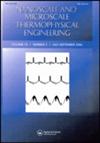Morphology-Driven Emissivity of Microscale Tree-like Structures for Radiative Thermal Management
IF 2.7
3区 工程技术
Q2 ENGINEERING, MECHANICAL
Nanoscale and Microscale Thermophysical Engineering
Pub Date : 2018-03-06
DOI:10.1080/15567265.2018.1446065
引用次数: 14
Abstract
ABSTRACT Spectral emissivity of surface materials has a strong impact on thermal properties of systems that are exposed in the ambient environment. While the solar spectrum heating up the surface ranges from 200 to 2,500 nm, the atmospheric transmission spectrum allowed for infrared cooling ranges from 8 to 14 µm. However, conventional surface materials have emissivity values that are either high or low throughout the spectrum. For example, ceramic materials are typically emissive and metallic materials are typically reflective and not emissive. Here, we show that surface materials with artificial periodicities can have a selectively controlled emissivity and that the surface morphology can transform ceramic materials to be reflective or metallic materials to be emissive. As a model system, we use microscale tree-like structures, or briefly micro-trees, to demonstrate wide variations of morphology-driven emissivity spectra. Our computation based on the rigorous coupled-wave analysis shows that optimal designs of micro-trees can act as a nearly perfect reflector or a black body depending on the spectral range and offer radiative cooling or heating capabilities beyond the limits of conventional materials. For cooling, metallic micro-trees provide a surface temperature 10 K lower than that of bare metallic surfaces in a normal ambient condition, and for heating, ceramic micro-trees provide a surface temperature 8 K higher than that of bare ceramic materials. The morphology-driven emissivity of micro-trees can offer a net cooling power of 136 W/m2 or a net heating power of 12 W/m2 depending on the application without requiring any active devices, and these results guide optimal designs of artificial materials for thermal management.用于辐射热管理的微尺度树状结构的形貌驱动发射率
表面材料的光谱发射率对暴露在环境中的系统的热性能有很大的影响。太阳光谱加热地表的范围为200至2500 nm,而大气透射光谱允许红外冷却的范围为8至14 μ m。然而,传统表面材料的发射率值在整个光谱中要么高要么低。例如,陶瓷材料通常是发射性的,而金属材料通常是反射性的而不是发射性的。在这里,我们证明了具有人工周期性的表面材料可以有选择性地控制发射率,并且表面形貌可以将陶瓷材料转变为反射材料或金属材料转变为发射材料。作为一个模型系统,我们使用微观尺度的树状结构,或简单的微观树,来展示形态驱动的发射率光谱的广泛变化。我们基于严格耦合波分析的计算表明,根据光谱范围,微树的最佳设计可以作为近乎完美的反射器或黑体,并提供超出传统材料限制的辐射冷却或加热能力。在正常环境条件下,金属微树的冷却表面温度比裸金属表面低10k,而在加热表面温度比裸陶瓷材料高8k。在不需要任何有源器件的情况下,微树的形态驱动发射率可以提供136w /m2的净冷却功率或12w /m2的净加热功率,这取决于应用,这些结果指导了用于热管理的人工材料的优化设计。
本文章由计算机程序翻译,如有差异,请以英文原文为准。
求助全文
约1分钟内获得全文
求助全文
来源期刊

Nanoscale and Microscale Thermophysical Engineering
工程技术-材料科学:表征与测试
CiteScore
5.90
自引率
2.40%
发文量
12
审稿时长
3.3 months
期刊介绍:
Nanoscale and Microscale Thermophysical Engineering is a journal covering the basic science and engineering of nanoscale and microscale energy and mass transport, conversion, and storage processes. In addition, the journal addresses the uses of these principles for device and system applications in the fields of energy, environment, information, medicine, and transportation.
The journal publishes both original research articles and reviews of historical accounts, latest progresses, and future directions in this rapidly advancing field. Papers deal with such topics as:
transport and interactions of electrons, phonons, photons, and spins in solids,
interfacial energy transport and phase change processes,
microscale and nanoscale fluid and mass transport and chemical reaction,
molecular-level energy transport, storage, conversion, reaction, and phase transition,
near field thermal radiation and plasmonic effects,
ultrafast and high spatial resolution measurements,
multi length and time scale modeling and computations,
processing of nanostructured materials, including composites,
micro and nanoscale manufacturing,
energy conversion and storage devices and systems,
thermal management devices and systems,
microfluidic and nanofluidic devices and systems,
molecular analysis devices and systems.
 求助内容:
求助内容: 应助结果提醒方式:
应助结果提醒方式:


